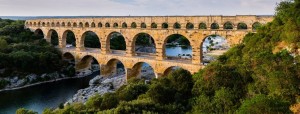Science Seen Physicist and Time One author Colin Gillespie helps you understand your world.
Getting Water When It Isn’t Getting Wetter
Climate change is no longer a forecast. It’s news. And even if we all stopped burning fossil fuels tomorrow climate change would go on getting worse. We see a range of consequences, like historically severe droughts. How does this affect us?
The UN International Decade for Action on water ends this year. Its webpage says: “Water is essential for life.” What will we say about this to our children and their children? As things stand, if we are honest we will say: “We waste water; we care little about life.” Or . . . we could do something different.
To grasp the opportunity, we need to understand the problem: We think we have lots of water. And, if we look after it, we do have lots of water. Each year, Earth’s great weather engine drops five hundred trillion tons of clean freshwater (though most of it falls into the sea). Then we waste it. This is putting city life at risk. And even those of us who do not live in cities live in an urban civilization. Not long ago New York was the world’s largest city by population. Now some twenty cities are larger. Soon there may be twenty Chinese cities larger than New York. Every one of these big cities lives (or dies) on water. Indeed, water supplies were integral to the birth of early cities. Twenty-seven hundred years ago a 55-km canal supplied water to Nineveh. By the first century CE, Roman aqueducts were moving water into many cities. Like, for example, the mostly-still-standing Pont du Gard built to cross a valley on the water’s 30-mile-long way to Nîmes. City water supplies were central to healthy life in the Roman Empire.
hundred trillion tons of clean freshwater (though most of it falls into the sea). Then we waste it. This is putting city life at risk. And even those of us who do not live in cities live in an urban civilization. Not long ago New York was the world’s largest city by population. Now some twenty cities are larger. Soon there may be twenty Chinese cities larger than New York. Every one of these big cities lives (or dies) on water. Indeed, water supplies were integral to the birth of early cities. Twenty-seven hundred years ago a 55-km canal supplied water to Nineveh. By the first century CE, Roman aqueducts were moving water into many cities. Like, for example, the mostly-still-standing Pont du Gard built to cross a valley on the water’s 30-mile-long way to Nîmes. City water supplies were central to healthy life in the Roman Empire.
Great cities have been wrecked by lack of water. Angkor (whose ruins are in today’s Cambodia) was a marvel for five hundred years. No doubt its inhabitants thought it would last forever; then the monsoons moved away. Today, as world-wide climate-change is underway, many cities are already facing water shortages that threaten their existence. For example, in Brazil Sao Paolo is a city of some twenty million people. Brazil receives far more rainwater than any other country. So you might think Sao Paolo is well-off (no pun) for water. Try googling sao paolo water! Or you could try beijing water shortage. Or try googling catastrophic drought and you will come across Los Angeles where it is now illegal for a restaurant to serve you water unless you ask for it.
In today’s global economy, what is bad for big cities is bad for everyone. So what can we do? In one word: Adapt. It’s a word we should be hearing more of soon. And the sooner we start doing it the better it will be for the economy.
Our water technologies and infrastructure no longer meet our needs. Many of our ways of water-use are wasteful. The good news is that water saved is even better than the same amount of new supply. We need to adapt new ways to conserve and manage water. We can invest in research and development, and in design and construction, of new water infrastructure. How do we pay for it? Right now many governments can borrow long-term money at extremely low cost—at a cost that is indeed so low it would be completely crazy not to do it. And as the ancient Romans did, we should truly value water, so everyone should pay a realistic price. When we hand out water for less than its worth we are subsidizing waste and forwarding the bill to future generations. It’s not only foolish; it’s unfair.
So here’s what each of us can do: Send a message to a politician; mention water and adapt; send copies to your friends. We have an opportunity to manage water well. If we do, our children and their children may yet come to thank us.
Sources:
United Nations, Department of Economic & Social Affairs, “International Decade for Action: Water for Life 2005-2015”, http://www.un.org/waterforlifedecade/background.shtml
Other Reading:
Richard Harris (2003), Pompeii, New York: Random House; http://en.wikipedia.org/wiki/Pompeii_(novel)
Trevor Hodge (1992), Roman Aqueducts & Water Supply, London: Gerald Duckworth & Co. Ltd.; http://www.amazon.com/Roman-Aqueducts-Supply-Duckworth-Archaeology/dp/0715631713
Image credits:
Benh Lieu Song, http://en.wikipedia.org/wiki/Pont_du_Gard#/media/File:Pont_du_Gard_BLS.jpg

No comments yet.